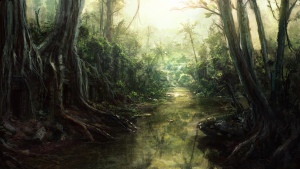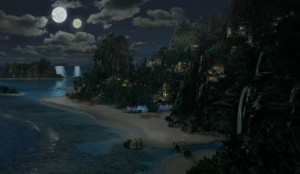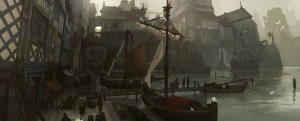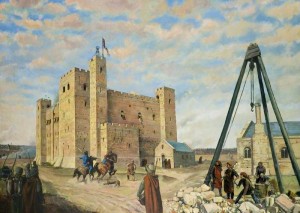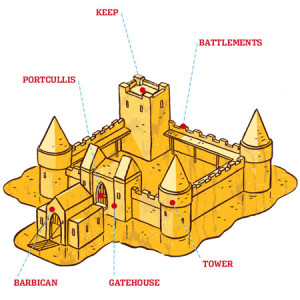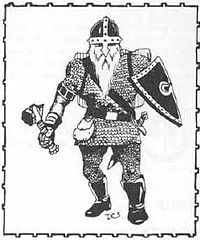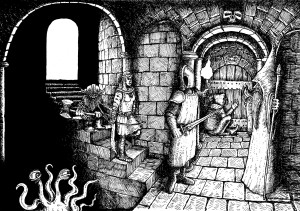[This is the seventh post in a series dissecting the campaign ‘bible’ document I drafted while planning my AD&D 1e campaign. See here for an introduction to this series of posts.]
Island Hopping: Adventure Locales
The last section of the campaign ‘bible’ detailing the physical aspects of the Curabel setting consists of a collection of minor islands that were intended to provide several different adventure locales for my players. However, I have not done much with any of the setting’s locations outside of Curmidden (the central island) since it has provided more than enough room for adventure through seventy-six sessions. This means that, with the exception of Lonely Isle, there is not much to say about these locations other than in terms of my original intentions in creating them.
Curabel
This island is where Imperials first landed. Now called Watcher’s Island, though no permanent settlement has existed here is more than a century.
My campaign has featured some intrigue involving the human empire located across the ocean to the east (albeit not as much recently), but the Watchers mentioned in this brief description have not been a presence at all. It was my thought that, if this semi-secret cabal dedicated to protecting the islands from Imperials had interacted with the party more, the existence of an unsettled island that this group intermittently occupies and located at the eastern end of the archipelago might prove an interesting adventure locale.
Serpent’s Tooth
This island is one of the most inhospitable of the islands, although ancient ruins still draw adventurers. There is one permanent settlement on the island’s western coast called “Poison Spit” that serves as the launching point for most expeditions into the interior. Most residents of this town are native humans who have been fishing the waters here since the ancient dwarven empire, although each failed expedition tends to add a few survivors to the local population.
Conceived as an area for higher-level adventure in a truly wild jungle setting, it hasn’t been necessary to flesh this island out any more than the above blurb. The dwarven ruins, imperial forts, and jungles of Curmidden have been sufficient to occupy the players to date. A secondary campaign that I run for middle school students (my wife is their teacher) will be headed here soon, though, so I will have a chance to fill in some of the blanks.
Crescent Isle
This is the breadbasket of the islands and home to the second-largest human city-state, Feldmark. Compared to Midmark on Curmidden, Feldmark is a small town with a modest harbor. There is not the same strict division between districts and modest residences can be found side-by-side with industrial and civic buildings.
The Feldmark city-state was intended to serve as a foil to the larger metropolis of Midmark — an agrarian society with stronger democratic (as opposed to aristocratic) traditions. However, neither of my campaigns have delved much into the tensions between the various human city-states. It is possible that this will change in my primary campaign, though, when the United Council of the Marks (mentioned later in the campaign bible) has their annual meeting in two months in-game time.
Agmar’s Folly
This island was a thriving rival to Midland and Crescent Isle until all the settlers disappeared under mysterious circumstances several decades ago. It is now avoided by all but the most desperate scavengers and pirates.
Somewhat of an homage to the Lost Colony of Roanoke, this locale was created as a straightforward adventure hook — a mystery for the players to solve, whether they sought it out on purpose or found themselves there while interacting with “scavengers and pirates.” I strongly suspect, though, that my players feel they have more than enough mystery on their plate right now between imperial spies, ancient dwarven gods that are less dead than previously thought, and slavery rings tied to corrupt guild, companies, and politicians on Curmidden.
Lonely Isle
This is a blasted and desolate island is often subject to geological instability.
It figures that this blank slate of an island, which just has a vague hint of adventure related to its “geological instability,” has become the one location on this list that figures prominently in my primary campaign. Part of this was anticipated during the initial design of the setting when I decided this island was an important location for the ancient dwarven empire that my players have been doggedly investigating. However, there was also a bit of serendipity owing to collaboration with one player who wanted to play a monk. Originally, this class was not part of my conception for the setting, but, since it was never explicitly banned from the campaign, I let this player help integrate it into the world. During that process, we decided together that this island would be the original headquarters of the Order of the Celestial Dragon, a fierce anti-imperial counter-espionage force. This Order recently abandoned their headquarters, though, in a diaspora intended to be an opportunity to find a more appropriate home after the island was overrun by a company interested in mining its resources. This company is the same one involved with the slavery ring and other shady business and its very likely that the campaign will eventually make its way to this location.
One last note on this collaborative world-building: typically, I am not a fan of letting the players contribute to the design of a campaign setting. The world and how it works is part of the mystery that players uncover as they play and that mystery is impossible to have if the eventual investigators design it. In this case, however, I was able to give the player the ability to make certain choices — like the name of the order and its headquarters — without telling him the significance of those choices or how they fit into the world (i.e., that the location was an important site already and that the order was a ‘reformed’ offshoot of the dervishes who served the human empire). In essence, the player chose some facts but I gave them the significance. This has happened a few more times in the campaign since then and I will definitely be experimenting with this approach more in the future.
Detailing the Heavens Above: Basic Cosmology
- Meidia has a single sun that travels east to west. Curabel’s days and nights are roughly equal year-round given its proximity to the equator.
- Meidia has two moons:
- Imperial: Cinthal, Cinmar (Shadow-son and Shadow-daughter)
- Dwarven: Fathil, Fatha (Dark hunter and Dark huntress)
- Elven: Mithilun, Cithilun (Silver-lady and Dark-lady)
- Currents and winds run east to west; since Midland straddles the equator, currents break to the north on islands north of that island and south to the south (on the eastward side) and flow around the top and then back either south or north (on the westward side)
- Storms are frequent but generally mild in this equatorial region
There is not too much to say about this bit of the campaign bible. With the exception of the double moons, most of these details reflect with information taken from the Wilderness Survival Guide or my own research into the tropical islands/climes. Looking back on the names of those moons, though, I am reminded of a linguistic connection intended between the imperial and Elven nomenclature — specifically the purposeful similarity between the “Cin” element in one and “Cith” in the other. This builds on the bit of historical lore I drafted about how the empire’s home in the east originally belonged to the elves before that latter groups conquest and exile to Curabel.
Quick Note About Upcoming Installments in this Series:
The next section of the campaign bible is about the setting’s various races. This is information I have covered already in my discussion of the individual islands in Curabel (see the posts on humans, elves, and dwarves). Rather than skip this section, though, I will be revisiting the peoples of Curabel and posting some tables of random backgrounds for new player characters that take into account both race and island of origin.

